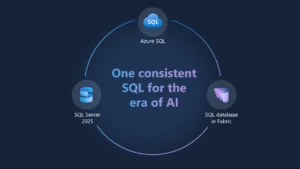Modernize Microsoft SQL Server 2014 workloads with Azure
We take pride in delivering innovation with each new version of Microsoft SQL Server. However, there comes a time when product lifecycles must conclude. As of July 9, 2024, SQL Server 2014 has reached its end of support. Many of our customers, including Scandinavian Airlines, have begun transitioning their SQL workloads to Microsoft Azure or are updating to SQL Server 2022. Their objective is straightforward: to modernize their databases and applications while accelerating innovation through using cloud technologies.
“With our migration to PaaS, we got what we wanted: greater scalability, reliability, security, agility in managing our IT infrastructure—and greater peace of mind—all without the cost and hassle of doing this ourselves,”
Daniel Engberg, Head of AI, Data, and Platforms at Scandinavian Airlines System

This blog post will guide you through several best practices our customers employed when faced with the SQL Server end-of-support moment. Customers have three choices for handling their out-of-support SQL Server workloads: moving or updating to Azure, upgrading to SQL Server 2022, or getting Extended Security Updates (ESUs) for additional preparation time.
Migrate and modernize to Azure, a smooth path, a more powerful destination
Migrating to a cloud platform is an essential step on the journey to modernization, and there are many choices. What makes SQL Server and Microsoft Azure SQL unique is that it’s built on the same engine, no matter where you deploy, which means you can build on your existing SQL experience while gaining the layered security, intelligent threat detection, and data encryption that Azure provides.
Modernizing to Microsoft Azure SQL Managed Instance offers cost savings, scalability, security, seamless migration, productivity, and always up-to-date features. Some of the recent product highlights include Azure SQL Managed Instance Next-gen General Purpose, now in public preview, which supports twice as many Azure VMs configurations, making migration and modernization faster and easier than ever before for a larger number of customer scenarios. Customers can experience the full capabilities of managed SQL Server in the cloud at no cost for the initial 12 months with access to a General Purpose instance capable of accommodating up to 100 databases, along with 720 vCore hours of compute per month (non-accumulative) and 64 GB of storage through Azure SQL Managed Instance Free Tier, now in public preview.
Modernizing your SQL Server workloads to Azure also presents a chance to utilize cutting-edge innovation like Microsoft Copilot. Microsoft Copilot in Azure has extended its capabilities to Microsoft Azure SQL Database with new skills designed to enhance the management and operation of SQL-based applications.
Extending end-of-support time
If you are ready to move to the cloud but feel challenged to upgrade or modernize before the end of the support timeline, Extended Security Updates are available for free in Azure for SQL Server 2014 and 2012 and Windows Server 2012. Secure your workloads for up to three more years after the end of the support deadline by migrating applications and SQL Server databases to Microsoft Azure Virtual Machines. Free Extended Security Updates are available for Azure Virtual Machines including Microsoft Azure Dedicated Host, Microsoft Azure VMWare Solution, Nutanix Cloud Clusters on Azure, and Microsoft Azure Stack (Microsoft Azure Stack Hub, Microsoft Azure Stack Edge, and Microsoft Azure Stack HCI). Combining Extended Security Updates in Azure with Azure Hybrid Benefit further reduces your costs. With these pricing advantages, AWS is up to five times more expensive than Azure for SQL Server and Windows Server end-of-support workloads.
In-place upgrade to SQL Server 2022
Another way to stay protected is to upgrade your SQL Server to SQL Server 2022, the most Azure-enabled release yet. Get more out of your data with enhanced security, industry-leading performance and availability, and business continuity through Azure.
SQL Server 2022 is the most Azure-enabled release of SQL Server, with continued innovation across performance, security, and availability. Gain deeper insights, predictions, and governance from your data at scale. Take advantage of enhanced performance and scalability with built-in query intelligence.
Stay protected on-premises or in multi-cloud environments with Azure Arc
Just as with SQL Server 2012, Extended Security Updates for SQL Server 2014 offers an enhanced cloud experience through Microsoft Azure Arc. First year coverage from Extended Security Updates started on July 10, 2024. With this more customer-centric approach, security updates will be natively available in the Microsoft Azure portal through Azure Arc. This also provides Azure benefits and flexible subscription billing for SQL Server 2014 workloads on-premises or in multi-cloud environments.
We’re continuing to enhance the capabilities Azure Arc offers to Extended Security Updates. Just recently, physical-core licensing with unlimited virtualization was released for SQL Server 2012 and 2014 ESUs. For customers who need to maximize database performance or require security isolation and better resource management, physical core licensing provides a more cost-effective way to leverage Extended Security Updates via Azure Arc.
Also, if you enabled ESU subscription in your production environment managed through Azure Arc, you can enable SQL Server ESU subscription in the non-production environment for free, through SQL Server Developer Edition or an Azure dev/test subscription.
We encourage all our customers running SQL Server 2014, Windows Server 2012, and Windows Server 2012 R2 to start planning for the end of support. We have migration resources, best practices, and more, as well as a rich ecosystem of partners ready to help. To get started, please visit the following pages to learn more.
Learn More
- Why migrate Windows Server and SQL Server to Azure: ROI, innovation, and free offers
- Get the full ROI and TCO reports from IDC: The Business Value of Microsoft Azure SQL Database and Azure SQL Managed Instance Workload and The Business Value of Microsoft Azure for SQL Server and Windows Server Workloads
- Previous announcement on SQL Server 2014 End-of-Support moment: Protect SQL Server 2014 workloads with Azure flexibility – Microsoft SQL Server Blog

